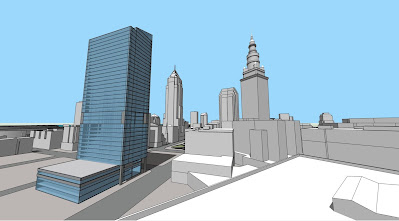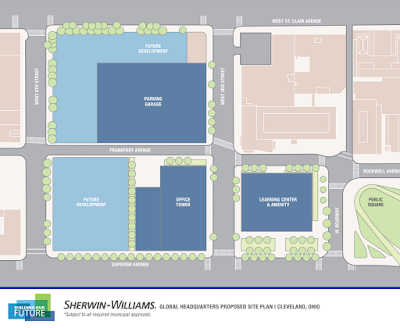 |
Featuring a sloping roofline approaching 600 feet above Superior
Avenue and West 3rd Street, the new Sherwin-Williams HQ tower
will join Terminal Tower, 200 Public Square and Key Tower as
the city's four tallest buildings and will be four of the six tallest
structures in the state of Ohio (Ian McDaniel).
CLICK IMAGES TO ENLARGE THEM |
By 2024, Cleveland's four tallest buildings will surround Public Square.
Barring an unlikely dramatic change in the tower's programming and design, Sherwin-Williams' (SHW) new global headquarters is nearing its final form. While some plans of the HQ may be submitted to the city this month, some interior designs may not be finalized by SHW's Build Our Future committee until after site preparation work gets under way this coming winter on the west side of downtown Cleveland's Public Square.
The biggest news is that HQ's tower final form will approach and possibly reach the 600 foot level above the northwest corner of Superior Avenue and West 3rd Street, according to sources on the HQ design team. Those sources also gave NEOtrans enough details to allow our graphics expert Ian McDaniel to sketch a rough massing of what the tower could look like and how it might appear contextually in the city's skyline.
As we have seen, the HQ's features have changed over time as the design process has moved along and outward from the tower's elevator/stairwell core. More changes could occur. However, the changes are becoming less dramatic as SHW gets ready to submit its first batch of blueprints to the City Planning Commission for review.
 |
How Sherwin-Williams' new HQ tower will appear in the downtown
Cleveland skyline as viewed from Lake Erie. It is assumed that the new
tower's sloping roofline will angle up to Public Square (Ian McDaniel). |
In addition to being about 600 feet tall, the HQ tower also would feature nearly 40 floors. The number of floors would equal that of the dark-green Erieview Tower on East 9th Street. But the physical height will exceed Erieview's 529 feet and put it firmly in fourth place among downtown Cleveland skyscrapers. Exceeding it will be
three of its Public Square neighbors -- 200 Public Square (45 stories, 658 feet), Terminal Tower (52 stories, 708 feet), and Key Tower (57 stories, 948 feet).
The reason is that the top of SHW's HQ will reportedly have a sloping roofline that reduces the size of the floorplates on the upper floors and tops off the structure with a decorative feature. The effect is similar to that of the much shorter Atria office complex in North York, suburban Toronto. It not only gives the building a soaring appearance, it can also differentiate it from other buildings, as a principal of SHW HQ architect Pickard Chilton recently explained.
At the 2017 grand opening of another tower with a sloping roofline, 609 Main in Houston also designed by Pickard Chilton, developer Gerald Hines urged Jon Pickard to "Tell them about the top of the building -- why it’s not a flat top!”
“Well, we thought that a flat top gets a little bit lost in the skyline,” Picard explained to the audience, including PaperCityMag.com. “If we could create a silhouette that is memorable, then wherever you are. . . you see that slope, then you know the building.”
 |
The sloping roofline of SHW's new HQ will reportedly be very
similar to that of one of the Atria II or III office buildings in
North York, Ontario, in suburban Toronto (Google). |
Even though the SHW HQ architect also designed 609 Main and both buildings will feature glass-curtain-wall exteriors, design team sources cautioned that SHW's HQ will have a different form. SHW's 1-million-square-foot HQ tower will be more boxy and angular below the sloping roofline. Floorplates will likely average about 25,000 to 27,000 square feet. That and large windows will allow natural light to penetrate deep into the office building.
And the tower will likely have indents in the exterior, including an outdoor terrace cut into the lower midsection of the building overlooking Public Square. While it won't be open to the public, the terrace will offer a unique corporate amenity space for employees, suppliers and clients.
The feature offers a similar "terrace with a view" as that which is notched into the exterior of Ernst & Young Tower, 950 Main Ave., although it faces toward Lake Erie and the Cuyahoga River. Such a space can also offer a place for employees to think, grasp a bigger picture and recharge their creativity.
"The key partners we have selected are aligned with our vision of creating a next-generation workplace that supports serving our customers at the highest level, retaining and attracting top talent and igniting creativity, collaboration and industry-leading innovation," said SHW Chairman and CEO John Morikis in a written statement last fall.
 |
SHW HQ architect Pickard Chilton has designed
glass-curtain-wall office towers with sloping rooflines
before, like 609 Main in Houston. However, the SHW
HQ will reportedly be more boxy (HarveyCleary). |
Sources said there's a possibility that SHW's HQ development team, notably general contractor Gilbane Co., will get started started on site work before Pickard Chilton and the interior architect, Vocon Partners LLC, submit their full package to the city for review. The design team is in no rush to finalize everything, especially the interior details.
Supplier sources indicate that the high cost of construction materials, namely steel but others as well, has pushed SHW's HQ construction estimates well above the minimum projected expenditure of $600 million. SHW HQ suppliers may wish to wait a few months before they start to place materials orders. Ratings agency Fitch Solutions estimates that steel prices will fall from the present record high of $883 per metric ton to $600 per metric ton in 2022.
In the meantime, SHW is soliciting employees to "Find their color" in the HQ's interior design and layout. And with over 1,700 SHW paint colors, "there's a perfect color for every mood, every space and every project," to quote a certain paint company's ads.
To that end, SHW has put mock-ups of proposed office designs on the second floor of the Midland Building -- one of the 91-year-old Landmark Office Buildings at 101 W. Prospect Ave. that the 155-year-old company has called home since they were built.
 |
From a Public Square view, the new SHW HQ may appear more
boxy but also will likely show its tallest side, reaching about 600
feet above the street. It will also have a terrace facing the square.
This imposing façade will fill a void in Public Square's street scene
for the first time in more than 30 years when two smaller office
buildings were demolished for an unbuilt tower (Ian McDaniel). |
After July 12, when all employees have returned to the office on a hybrid schedule of three days a week, they will have the opportunity to take a walk through their potential future workspaces and give their feedback to members of the design team. Only managers have toured the mock-ups so far.
Among the proposed work spaces are smaller cubes and collaboration rooms. There is a more open floor layout of cubes, more seating areas to do ad hoc meetings or to take one-off calls. SHW considers its current HQ as antiquated and not meeting the work needs of today. Up to 3,500 people will work in the new building.
"A new space was developed on 2-Midland to provide employees a peek into what the new workplace experience will be in our future HQ," according to a notice distributed to SHW employees in the first week of June.
"Last week," it continued, "we kicked-off guided tours for employees. HQ, BTC (Breen Technology Center) and WTC (Warrensville Technology Center) employees will be invited to attend a tour over the next few months. Be on the lookout for your invite between June and August. Beginning in September, self-guided tours will be available during regular office hours."
 |
As viewed from the south side of downtown Cleveland, the new
SHW HQ tower will fill a wide gap in the city's skyline west of
Public Square with a significant skyscraper (Ian McDaniel). |
SHW is putting extra effort into the interior design details after
getting some pushback earlier this year from some members of the design team. Those members criticized the C-Suite-level Build Our Future committee on open-floor designs as well as a design concept of having employees work from any cubicle or workstation.
While the HQ will rise one block west of Public Square, SHW continues to plan for its new Center of Excellence (CofE) fronting the square. The CofE will be three stories tall and serve as a learning center and amenity space, as noted on SHW's official site plans.
The structure will reportedly offer up to 80,000 square feet of conference facilities for employee training and corporate functions, a small company museum for touring new recruits and VIPs, plus a rooftop lounge for after-work cocktail parties.
The CofE will be used as SHW's talent recruitment venue, sources said. It is proposed to be connected to the HQ via a skybridge above West 3rd. The HQ, in turn, will be connected to a large parking garage via a skybridge above Frankfort Avenue.
The new parking garage will have a liner building along West 3rd to comply with the city's building code. That liner building must hide the parking deck along its entire street frontage with at least 70 percent of that building comprised of active uses such as retailers, restaurants, hotel lobbies, residences, cultural amenities or recreational spaces.
 |
| Official Sherwin-Williams headquarters site plan (SHW). |
Sources continue to say that no public uses will be provided along Frankfort or in the interior of the HQ tower. Instead, there will be a loading dock for the HQ tower on Frankfort, shown as a notch on the official site plan. However, the tower may be angled to open up a larger sidewalk area at the corner of West 3rd and Superior where a sidewalk café or other public space could be provided.
SHW will not use all of the land it acquired last year for the HQ. Instead, it is opening up its property along West 6th, St. Clair and Frankfort for development in order to expand mixed uses from the Warehouse District into the HQ campus area.
That could allow some public uses along Frankfort immediately east of West 6th or be held for future HQ expansions. However, none of those potential uses or activities have been identified thus far.
Way back in October 2018, NEOtrans was the first to report that SHW was pursuing a new HQ. We were also first to report the hiring of many of SHW's HQ project partners in 2019 as well as the selection of the west side of Public Square as the site of the new HQ.
The company had also hoped to build its new research and development facility on Scranton Peninsula near downtown but apparently couldn't get landowner Scranton Averell Inc. to return phone calls. NEOtrans noted that Brecksville's ex-VA Hospital site was in the running; SHW ultimately chose it for the R&D facility.
END













